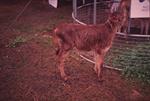Learn to Produce Healthy Calves or Improve Your Current Calf Production
Study the proper management of a cow's pregnancy and birth; and appropriately raising of a new animal. Learn about housing, weaning, and general health management. A useful course for farmers, farm hands, breeders or anyone contemplating a future in the dairy or beef industries.

Course Duration: 100 hours
Course Structure:
There are 7 lessons in this course:
- Calving and Culling
- Introduction
- Research into raising dairy calves
- Principles of good calf rearing
- Pre-calving management
- Managing the cow for a healthy calf
- Colostrum management
- Calf selection
- Estimated Breeding Value (EBV)
- Culling
- Assessing calves for suitability in a rearing system
- Calving Management
- The birth of a calf
- Signs that the birth is close
- Stages in a normal birth
- Calving problems
- Important points
- Abnormal presentations
- The calf at birth
- Colostrum
- Stress and pathogen exposure
- Managing stress
- Managing pathogen exposure
- The calf digestive tract
- Rumen development
- Bacteria
- Liquid in the rumen
- Outflows of rumen materials
- Absorptive qualities
- Substrate (Dry feed Intake)
- Calf Health Management
- Overview
- Common calf diseases
- Scours
- Coccidiosis
- Round Worm Scours
- Lung worm
- Calf diptheria
- Pneumonia
- Clostridial Disease
- salmonella
- Navel and joint ill
- Stress and the young calf
- Transport stress
- Feeding stress
- Heat and cold
- Calf-Rearing Systems
- Birth to weaning
- Natural Systems of Calf Rearing
- Single suckling
- Multiple suckling
- Foster suckling
- Race suckling
- Early weaning
- Artificial systems of calf rearing
- Teaching the calf to drink
- A basic Feeding program
- Milk Substitute
- Common calf rearing systems
- Rearing calves at grass
- Five and a half day system
- Once a day system
- Cold milk system
- Acidified milk replacers
- Mildly acidic milk replacers
- Strongly acidic milk replacers
- Milk-fed veal production
- Calf Housing
- Ventilation
- Isolation
- Comfort
- Economy
- Calf Pens
- Metal crates
- The calf hutch
- Weaning
- Stress at weaning
- General weaning transition strategies
- Providing water
- Weaning at twelve and eight weeks
- Weaning at five weeks
- Weaning at four weeks
- Post-weaning
- Post weaning period
- Calf husbandry practices
- Reducing surgical stress
- Cattle identification
- Castration
- Bloodless castration
- Surgical Castration
- Dehorning
- When to dehorn
- Dehorning instruments and equipment
- Tetanus
- Vaccination and Worming
Determine Calf Suitability for a Rearing System
By properly managing the pregnancy, birth and raising of a new animal there is inevitably less cost for the farmer, and healthier adult cattle.This ultimately means a more profitable farm.
This should be the first step of any selection process. Even if a calf is genetically superior, it is of no value at all if it is deformed or weak. The farmer should examine the calf shortly after birth, looking for the following features.
The size and weight of the calf
A large calf will often grow into a large cow so many people try to target higher birth weights, but this can be counter productive. For most of the dairy breeds, a heifer calf should weigh 35 kg at birth although Jersey calves will weigh less than this. However, high birth weight is one of the most significant factors leading to calving difficulty. For this reason, it is best to use a Bull with an EBV the same or lower than that of the cow, but select one with a higher EBV for growth potential. In this way, calving difficulties can be reduced without impacting significantly on herd productivity. Having said this, calves that are born very small and weak may need to be culled.
Deformities
Look particularly at the jaws to ensure they meet properly and are not undershot or overshot. The calf should also be examined for signs of blindness, loss of hair, a bent back etc. Any calf that is abnormal at birth should be killed and not kept for rearing. (Allow for normal unsteadiness and fuzzy vision at birth - both will noticeably improve as the hours pass).
Legs and feet
Make a very careful examination of the feet and legs of the calf and make sure they are straight and perfectly formed. Avoid calves that have very bent back legs which is a condition known as sickle hocks. All dairy animals have to walk back and forth to the dairy buildings as well as about the camps or paddocks while grazing so good, strong legs are essential.
Teats
Examine the teats of the young heifer calf carefully to make sure it has four teats that are well spaced out and not cramped together. This is most important if the animal is going to be milked with a machine later in life.
Praise for this Course:
"Been working in the livestock (Dairy Cattle) industry for years and thought I knew it all. Calf rearing was one area I had limited knowledge of, and due to a new work role, I needed to know more... QUICKLY!!! This course allowed me the freedom to work within the industry and learn at the same time. I learnt a lot of new and diverse calf rearing options that have now better prepared me for the 'real world' of calf rearing and my new role within the dairy industry. A great 'grounding' course, even for those who are hands on in raising claves. I have recommended this course to a few calf rearers already! I'd be happy to highly recommend the course to anyone with an interest in raising the next quality batch of calf replacements on their farm."
Tiffany Gordon, Australia
"I would recommend this course to anyone who wants to raise calves!!"
R. Beitlich, Australia